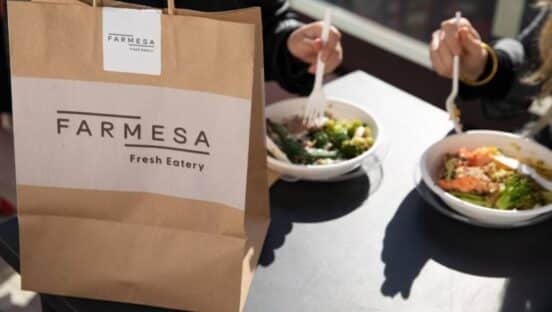In the wake of COVID, virtual concepts have turned into culinary goldmines. The industry could potentially reach $1 trillion by 2030, according to research firm Euromonitor International. In early February, Chipotle joined the fun with Farmesa, a virtual concept offered via Kitchen United in Santa Monica, California. So far, the fast casual is one of the largest restaurant chains to explore this emerging culinary space.
For Chipotle, the new venture represents a departure from the traditional ways in which restaurants operate. Executives such as Nate Lawton, the vice president of new ventures for Farmesa, are confident the new brand will allow the company to test future concepts and learn more about what it means to run a successful virtual restaurant.
In the past, Chipotle has tried secondary food and beverage ideas, such as Tasty Made and ShopHouse Southeast Asian Kitchen. However, Farmesa is the company’s first move into ghost kitchens, driven by a growing better-for-you fast-casual category and the promise to deliver fresh, real ingredients to a wider consumer base. The inception of Farmesa was fueled by a fusion of Chipotle concepts and innovations. Lawton expresses “there are some great things we learned from Chipotle that have allowed us to design what we think is super exciting in this space.”
While Chipotle has seen modernization in the way of operations, store layout, and technology partnerships, Lawton points out Farmesa’s menu is what will truly connect with consumers and keep them coming back for more. Nate Appleman, a James Beard award-winning chef, serves as director of culinary innovation for Farmesa. A Chipotle veteran, Appleman was the driving force behind the brand’s menu in the mid-to-late 2000s. During Farmesa’s infancy, Appleman teamed up with Lawton to discover what customers were looking for on a menu.
“I spent four months with chef Appleman out in the marketplace, just trying to immerse ourselves in what people in the U.S. were looking for,” Lawton says. “We found that ‘fresh eateries’ had the type of food many people were looking to eat multiple times a week.”
Farmesa’s menu, inspired by Chipotle’s “Food with Integrity” standards, includes fresh proteins, greens, grains, and vegetables assembled into a bowl which ranges in price from $11.95 to $16.95. A standard bowl includes a protein, green or grain, two sides, a topping, and a choice of five sauces. Additionally, Farmesa partnered with Tractor Beverage Co. to provide 100 percent organic and all-natural drinks. According to Lawton, the virtual brand reflects the “fresh, real ingredients and classic culinary techniques” of Chipotle, but the digital model allows room to learn and adapt to customer tastes. The partnership with Kitchen United grants Farmesa the opportunity to be flexible and make changes as time passes.
“One of the things we learned from our past ventures is that we wanted to get out and learn on our menu with consumers quickly, which is why we chose this approach,” Lawton explains, regarding the decision to launch Farmesa in a ghost kitchen. “We want to adapt and evolve as we go.”
To launch expeditiously, the ghost concept started with a limited menu. However, customers can now explore a menu that includes items like tri-trip steak, king salmon, and sweet potato chips. Before Farmesa launched at full throttle, Lawton says there were three areas of focus for the brand—consumer experience, operational consistency, and financial attractiveness. This “grow-as-we-go” approach is deliberate, as Lawton’s goal is to get on the market and start learning from consumers immediately.
“We knew that if we put the initial menu into the market, we would get consumer feedback right away,” Lawton says. “We would adapt or evolve in that view as we go … We have the flexibility to do that.”
From an operational perspective, Farmesa’s kitchen is set up for culinary flexibility.
From fryers to open-flame grills, there are a variety of resources available.
“We went in with a base set of assumptions of how we would operate the menu, but we also knew there would be opportunities to improve,” Lawton says. “We knew the menu would change, so we wanted to have the flexibility there.”
Additionally, the Kitchen United partnership allowed Farmesa to move from concept menu design to market in about six months.
For reference, a traditional restaurant concept would take anywhere from 15 to 20 months.
Lawton explains the decision to operate through a ghost kitchen was made with “the expectation that we would be learning and iterating through the process.”
Kitchen United’s technology platform also aided in Farmesa’s quick arrival onto the market. This platform allows guests to choose their location, shop for meals, and select pickup or delivery.
In fact, guests looking to eat at Farmesa have multiple order options: an onsite kiosk in Santa Monica, takeout from Farmesa’s website, or scheduled delivery through third-party service providers.
Between Farmesa’s menu, diverse kitchen space, and Kitchen United’s partnership, an ability to adjust and grow has been built into the brand’s mold from the beginning.
“I think what you’ll see in the foreseeable future for us is continuing to tinker or make bigger changes based on what we learn,” Lawton says. “We want to get this proposition as clear and as consistent for consumers as we believe it should be.”







